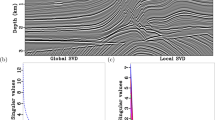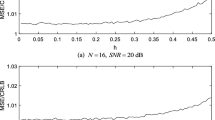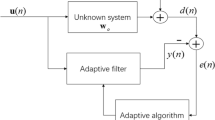Abstract
Adaptive systems protecting pulse radars from non-stationary in time (range) clutter echoes are usually tuned using training vectors composed of complex amplitudes of input signals and comprising a finite-length “sliding window” of data. From any current range gate to a subsequent one, a training sample is partially updated (or modified) by means of excluding the “old” training vectors (correspond to the current range gate) and including the “new” ones (correspond to the next range gate). As a consequence, respective estimates of adaptive system parameters are corrected according to a modified sample correlation matrix (CM), which is typically a sum of an initialCMand a modifying matrix of rank K ≥ 1. In this case it is possible to avoid re-computing these parameters based on a new training sample of full size and, instead of this, we correct them in an “economical” way employing K-rank modification of a matrix inverse to the CM estimate.
This paper is devoted to comparative analysis of various (K ≥ 1)-rank modification algorithms that correct the parameters of adaptive lattice filters (ALF). Main attention is paid to synthesis as well as theoretical and experimental study of algorithms of direct (K > 1)-rank modification of the ALF parameters. These algorithms attain the said objective omitting the K-fold application of known rank-one (K = 1) modification algorithms. We also synthesize a combined algorithm (CA) of (K ≥ 1)-rank modification of the ALF parameters that is more computationally simple and more numerically robust compared to known algorithms. The ALF employing the CA can serve as an effective tool for solving various tasks of space-time adaptive signal processing in pulse radars of different purpose.
Similar content being viewed by others
References
Y. D. Shirman (ed.), Radioelectronic Systems: Fundamentals of Construction and Theory, Handbook, 2nd ed. [in Russian] (Radiotekhnika, Moscow, 2007).
J. R. Rice, Matrix Computations and Mathematical Software (McGraw-Hill, New York, 1981).
V. V. Voevodin, E. E. Tyrtyshnikov, Computational Processes with Toeplitz Matrices [in Russian] (Nauka, Moscow, 1987).
P. E. Gill, W. Murray (eds.), Numerical Methods for Constrained Optimization (Academic Press, New York, 1974).
V. V. Voevodin, Computational Fundamentals of Linear Algebra [in Russian] (Nauka, Moscow, 1977).
H. Lev-Ari, T. Kailath, “Schur and Levinson algorithms for nonstationary processes,” in: Proc. of IEEE Int. Conf. on Acoustics, Speech, and Signal Processing, ICASSP’81, 30 Mar.-1 Apr. 1981, Atlanta, GA, USA (IEEE, 1981). DOI: 10.1109/ICASSP.1981.1171194.
D. I. Lekhovytskiy, “Generalized Levinson algorithm and universal lattice filters,” Radiophys. Quantum Electron. 35, No. 9–10, 509 (1992). DOI: 10.1007/BF01044971.
J. P. Burg, “A new analysis technique for time series data,” Proc. of NATO Advanced Study Institute on Signal Processing with Emphasis on Underwater Acoustics, Enschede, The Netherlands (Enschede, Netherlands, 1968).
F. Itakura, S. Saito, “Digital filtering techniques for speech analysis and synthesis,” Proc. of 7th Int. Congress on Acoustics, Budapest, Hungary (Akadémiai Kiadó, Budapest, 1971), Vol. 3, pp. 261–264.
A. Gray, J. Markel, “Digital lattice and ladder filter synthesis,” IEEE Trans. Audio Electroacoust. 21, No. 6, 491 (1973). DOI: 10.1109/TAU.1973.1162522.
B. Friedlander, “Lattice filters for adaptive processing,” Proc. IEEE 70, No. 8, 829 (1982). DOI: 10.1109/PROC. 1982.12407.
B. Friedlander, “Lattice methods for spectral estimation,” Proc. IEEE 70, No. 9, 990 (1982). DOI: 10.1109/PROC.1982.12429.
C. F. N. Cowan, P. M. Grant (eds.), Adaptive Filters (Prentice Hall, Englewood Cliffs, NJ, 1985).
A. H. Sayed, Fundamentals of Adaptive Filtering (John Wiley & Sons, Hoboken, NJ, 2003).
V. I. Djigan, Adaptive Filtering of Signals: Theory and Algorithms [in Russian] (Tekhnosfera, Moscow, 2013).
D. I. Lekhovytskiy, D. S. Rachkov, A. V. Semeniaka, V. P. Riabukha, D. V. Atamanskiy, “Adaptive lattice filters. Part I. Theory of lattice structures,” Prikladnaya Radioelektronika 10, No. 4, 380 (2011).
D. I. Lekhovytskiy, D. S. Rachkov, A. V. Semeniaka, V. P. Riabukha, D. V. Atamanskiy, “Adaptive lattice filters. Part II. Algorithms for ALF adjustment,” Prikladnaya Radioelektronika 10, No. 4, 405 (2011).
D. I. Lekhovytskiy, S. B. Milovanov, I. D. Rakov, B. G. Sverdlov, “Universal adaptive lattice filters. Adaptation for a given root of the estimating correlation matrix,” Radiophys. Quantum Electron. 35, No. 11–12, 621 (1992). DOI: 10.1007/BF01046658.
D. I. Lekhovytskiy, “Thirty years experience in development of adaptive lattice filters theory, techniques and testing in Kharkiv,” Proc. of 2011 VIII Int. Conf. on Antenna Theory and Techniques, ICATT, 20–23 Sept. 2011, Kyiv, Ukraine (IEEE, 2011). DOI: 10.1109/ICATT.2011.6170713.
R. Nitzberg, “Application of maximum likelihood estimation of persymmetric covariance matrices to adaptive processing,” IEEE Trans. Aerosp. Electron. Syst. AES-16, No. 1, 124 (1980). DOI: 10.1109/TAES.1980.308887.
D. I. Lekhovytskiy, “To the theory of adaptive signal processing in systems with centrally symmetric receive channels,” EURASIP J. Adv. Signal Process. 2016, No. 33 (2016). DOI: 10.1186/s13634-016-0329-z.
A. De Maio, D. Orlando, “An invariant approach to adaptive radar detection under covariance persymmetry,” IEEE Trans. Signal Process. 63, No. 5, 1297 (2015). DOI: 10.1109/TSP.2014.2388441.
Y. V. Shkvarko, “Unifying experiment design and convex regularization techniques for enhanced imaging with uncertain remote sensing data—Part I: Theory,” IEEE Trans. Geosci. Remote Sens. 48, No. 1, 82 (2010). DOI: 10.1109/TGRS.2009.2027695.
Y. V. Shkvarko, “Unifying experiment design and convex regularization techniques for enhanced imaging with uncertain remote sensing data—Part II: Adaptive implementation and performance issues,” IEEE Trans. Geosci. Remote Sens. 48, No. 1, 96 (2010). DOI: 10.1109/TGRS.2009.2027696.
Y. V. Shkvarko, J. Tuxpan, S. Santos, “Dynamic experiment design regularization approach to adaptive imaging with array radar/SAR sensor systems,” Sensors 11, No. 5, 4483 (2011). DOI: 10.3390/s110504483.
G. D. Martín del Campo, A. Reigber, Y. V. Shkvarko, “Resolution enhanced SAR tomography: bold roman A nonparametric iterative adaptive approach,” in: Proc. of 2016 IEEE Int. Geoscience and Remote Sensing Symp., IGARSS, 10–15 Jul. 2016, Beijing, China (IEEE, 2016). DOI: 10.1109/IGARSS.2016.7729838.
D. S. Rachkov, D. I. Lekhovytskiy, “Lattice-filter-based unified structure of system for interperiod processing of weather radar signals,” in: Proc. of 2015 IEEE Radar Conf., RadarCon, 10–15 May 2015, Arlington, USA (IEEE, 2015), pp. 1234–1239. DOI: 10.1109/RADAR.2015.7131183.
D. S. Rachkov, D. I. Lekhovytskiy, A. V. Semeniaka, B. M. Vovshin, U. U. Laurukevich, “Lattice implementation of ‘superresolving’ methods for meteorological objects spectra estimation,” in: Proc. of 2014 15th Int. Radar Symp., IRS, 16–18 Jun. 2014, Gdansk, Poland (IEEE, 2014), pp. 35–38. DOI: 10.1109/IRS. 2014.6869229.
K. C. Sharman, T. S. Durrani, “Spatial lattice filter for high-resolution spectral analysis of array data,” IEE Proc. F -Commun., Radar Signal Process. 130, No. 3, 279 (1983). DOI: 10.1049/ip-f-1:19830047.
I. S. Reed, J. D. Mallett, L. E. Brennan, “Rapid convergence rate in adaptive arrays,” IEEE Trans. Aerosp. Electron. Syst. AES-10, No. 6, 853 (1974). DOI: 10.1109/TAES.1974.307893.
D. S. Rachkov, D. I. Lekhovytskiy, A. V. Semeniaka, V. P. Riabukha, D. V. Atamanskiy, “Lattice-filter-based ground clutter canceller for pulse Doppler weather radar,” in: Proc. of 2014 15th Int. Radar Symp., IRS, 16–18 Jun. 2014, Gdansk, Poland (IEEE, 2014), pp. 215–219. DOI: 10.1109/IRS.2014.6869251.
D. I. Lekhovytskiy, D. V. Atamanskiy, V. P. Riabukha, D. S. Rachkov, A. V. Semeniaka, “Combining target detection against the background of jamming signals and jamming signal DOA estimation,” in: Proc. of 2015 Int. Conf. on Antenna Theory and Techniques, ICATT, 21–24 Apr. 2015, Kharkiv, Ukraine (IEEE, 2015), pp. 36–40. DOI: 10.1109/ICATT.2015.7136777.
W.-H. Yang, S. H. Holan, C. K. Wikle, “Bayesian lattice filters for time-varying autoregression and time-frequency analysis,” Bayesian Analysis 11, No. 4, 977 (2016). DOI: 10.1214/15-BA978.
M. T. Ozden, “Sequential convex combinations of multiple adaptive lattice filters in cognitive radio channel identification,” EURASIP J. Adv. Signal Process. 2018, 45 (2018). DOI: 10.1186/s13634-018-0567-3.
A. Castillo-Atoche, D. Torres-Roman, Y. V. Shkvarko, “Towards real time implementation of reconstructive signal processing algorithms using systolic array coprocessors,” J. Syst. Archit. 56, No. 8, 327 (2010). DOI: 10.1016/j.sysarc.2010.05.004.
Y. V. Shkvarko, J. I. Yanez, J. A. Amao, G. D. Martín del Campo, “Radar/SAR image resolution enhancement via unifying descriptive experiment design regularization and wavelet-domain processing,” IEEE Geosci. Remote Sens. Lett. 13, No. 2, 152 (2016). DOI: 10.1109/LGRS.2015.2502539.
Y. I. Abramovich, N. K. Spencer, B. A. Johnson, “Band-inverse TVAR covariance matrix estimation for adaptive detection,” IEEE Trans. Aerosp. Electron. Syst. 46, No. 1, 375 (2010). DOI: 10.1109/TAES.2010. 5417169.
D. I. Lekhovytskiy, Y. I. Abramovich, “Adaptive lattice filters for band-inverse (TVAR) covariance matrix approximations: theory and practical applications,” in: Proc. of 2009 Int. Radar Symp., IRS 2009, Hamburg, Germany (TUHH, Hamburg, 2009), pp. 535–539.
D. Lee, M. Morf, B. Friedlander, “Recursive least squares ladder estimation algorithms,” IEEE Trans. Acoust., Speech, Signal Process. 29, No. 3, 627 (1981). DOI: 10.1109/TASSP.1981.1163587.
H. Dym, I. Gohberg, “Extensions of band matrices with band inverses,” Linear Algebra and its Applications 36, 1 (1981). DOI: 10.1016/0024-3795(81)90215-9.
Y. I. Abramovich, N. K. Spencer, M. D. E. Turley, “Time-varying autoregressive (TVAR) models for multiple radar observations,” IEEE Trans. Signal Process. 55, No. 4, 1298 (2007). DOI: 10.1109/TSP.2006.888064.
Y. I. Abramovich, N. K. Spencer, M. D. E. Turley, “Order estimation and discrimination between stationary and time-varying (TVAR) autoregressive models,” IEEE Trans. Signal Process. 55, No. 6, 2861 (2007). DOI: 10.1109/TSP.2007.893966.
Y. I. Abramovich, B. A. Johnson, “Adaptive radar detection for sample-starved Gaussian training conditions,” in: A. De Maio, M. S. Greco [eds.], Modern Radar Detection Theory (SciTech Publishing, Edison, NJ, 2016), pp. 165–262. DOI: 10.1049/SBRA509E_ch6.
W. L. Melvin, “Space-time adaptive processing for radar,” in: N. D. Sidiropoulos, F. Gini, R. Chellappa, S. Theodoridis, (eds.), Academic Press Library in Signal Processing. Vol. 2: Communications and Radar Signal Processing (2014), Chapter 12, pp. 595–665. DOI: 10.1016/B978-0-12-396500-4.00012-0.
Y. I. Abramovich, N. K. Spencer, A. Y. Gorokhov, “Modified GLRT and AMF framework for adaptive detectors,” IEEE Trans. Aerosp. Electron. Syst. 43, No. 3, 1017 (2007). DOI: 10.1109/TAES.2007.4383590.
P. E. Gill, G. H. Golub, W. Murray, M. A. Saunders, “Methods for modifying matrix factorizations,” Math. Comp. 28, No. 126, 505 (1974). DOI: 10.1090/S0025-5718-1974-0343558-6.
K. D. Ikramov, Numerical Methods for Symmetric Linear Systems [in Russian] (Nauka, Moscow, 1988).
D. T. L. Lee, “Canonical ladder form realizations and fast estimation algorithms,” Ph.D. Dissertation (Stanford, CA, 1980).
O. Krause, C. Igel, “A more efficient rank-one covariance matrix update for evolution strategies,” in: Proc. of 2015 ACM Conf. on Foundations of Genetic Algorithms XIII, FOGA’15, 17–22 Jan. 2015, Aberystwyth, United Kingdom (ACM, New York, 2015), pp. 129–136. DOI: 10.1145/2725494.2725496.
Z. Li, Q. Zhang, “An efficient rank-1 update for Cholesky CMA-ES using auxiliary evolution path,” in: Proc. of 2017 IEEE Congress on Evolutionary Computation, CEC, 5–8 Jun. 2017, San Sebastian, Spain (IEEE, 2017). DOI: 10.1109/CEC.2017.7969406.
Z. Li, Q. Zhang, “A simple yet efficient rank one update for covariance matrix adaptation,” arXiv preprint (2017). 16 p. URI: https://doi.org/arxiv.org/abs/1710.03996.
H.-G. Beyer, B. Sendhoff, “Simplify your covariance matrix adaptation evolution strategy,” IEEE Trans. Evol. Comput. 21, No. 5, 746 (2017). DOI: 10.1109/TEVC.2017.2680320.
S. J. Olszanskyj, J. M. Lebak, A. W. Bojanczyk, “Rank-k modification methods for recursive least squares problems,” Numer. Algor. 7, No. 2, 325 (1994). DOI: 10.1007/BF02140689.
H. Oh, Z. Hu, “Multiple-rank modification of symmetric eigenvalue problem,” MethodsX 5, 103 (2018). DOI: 10.1016/j.mex.2018.01.001.
L. Deng, “Multiple-rank updates to matrix factorizations for nonlinear analysis and circuit design,” Ph.D. Dissertation (Stanford, CA, 2010).
R. Bellman, Introduction to Matrix Analysis (McGraw-Hill, New York, 1960).
I. Stanimirovic, Computation of Generalized Matrix Inverses and Applications (Apple Academic Press, Waretown, NJ, 2017).
C. M. Rader, A. O. Steinhardt, “Hyperbolic Householder transformations,” IEEE Trans. Acoust., Speech, Signal Process. 34, No. 6, 1589 (1986). DOI: 10.1109/TASSP.1986.1164998.
A. W. Bojanczyk, A. O. Steinhardt, “Stabilized hyperbolic Householder transformations,” IEEE Trans. Acoust., Speech, Signal Process. 37, No. 8, 1286 (1989). DOI: 10.1109/29.31277.
A. W. Bojanczyk, J. G. Nagy, R. J. Plemmons, Row Householder transformations for rank-k Cholesky inverse modifications. IMA Preprint Series 978 (University of Minnesota, Minneapolis, MN, 1992). URI: https://doi.org/hdl.handle.net/11299/1897.
D. I. Lekhovytskiy, D. S. Rachkov, A. V. Semeniaka, “K-rank modification of adaptive lattice filter parameters,” in: Proc. of 2015 IEEE Radar Conf., RadarCon, 10–15 May 2015, Arlington, VA, USA (IEEE, 2015). DOI: 10.1109/RADAR.2015.7130983.
Y. I. Abramovich, “Controlled method for adaptive optimization of filters using the criterion of maximum signal-to-noise ratio,” Radiotekh. Elektron. 26, No. 3, 87 (1981).
H. V. Henderson, S. R. Searle, “On deriving the inverse of bold roman a sum of matrices,” SIAM Rev. 23, No. 1, 53 (1981). DOI: 10.1137/1023004.
Author information
Authors and Affiliations
Corresponding author
Additional information
Original Russian Text © D.I. Lekhovytskiy, 2018, published in Izvestiya Vysshikh Uchebnykh Zavedenii, Radioelektronika, 2018, Vol. 61, No. 11, pp. 607–644.
About this article
Cite this article
Lekhovytskiy, D.I. Adaptive Lattice Filters for Systems of Space-Time Processing of Non-Stationary Gaussian Processes. Radioelectron.Commun.Syst. 61, 477–514 (2018). https://doi.org/10.3103/S0735272718110018
Received:
Revised:
Accepted:
Published:
Issue Date:
DOI: https://doi.org/10.3103/S0735272718110018




